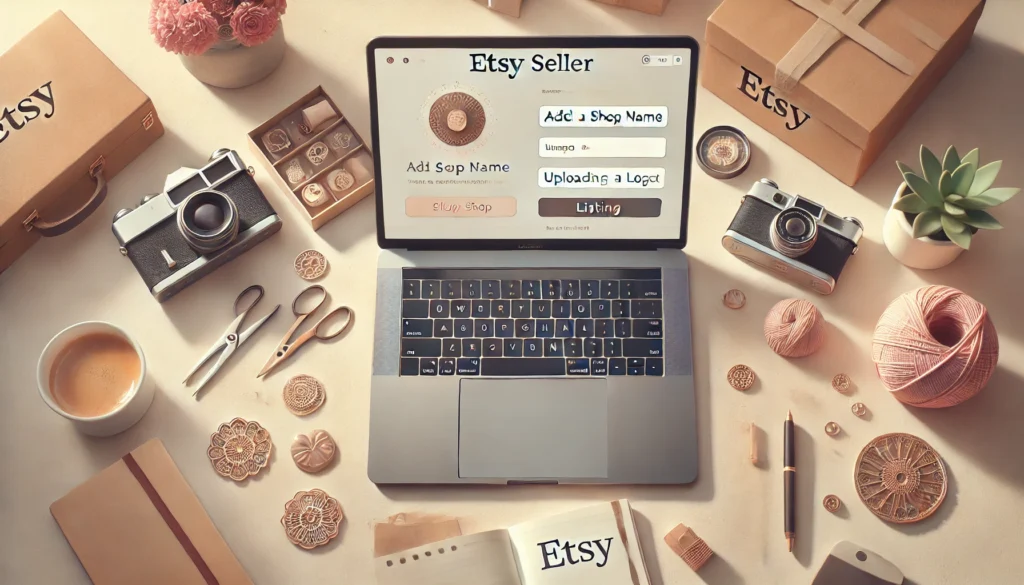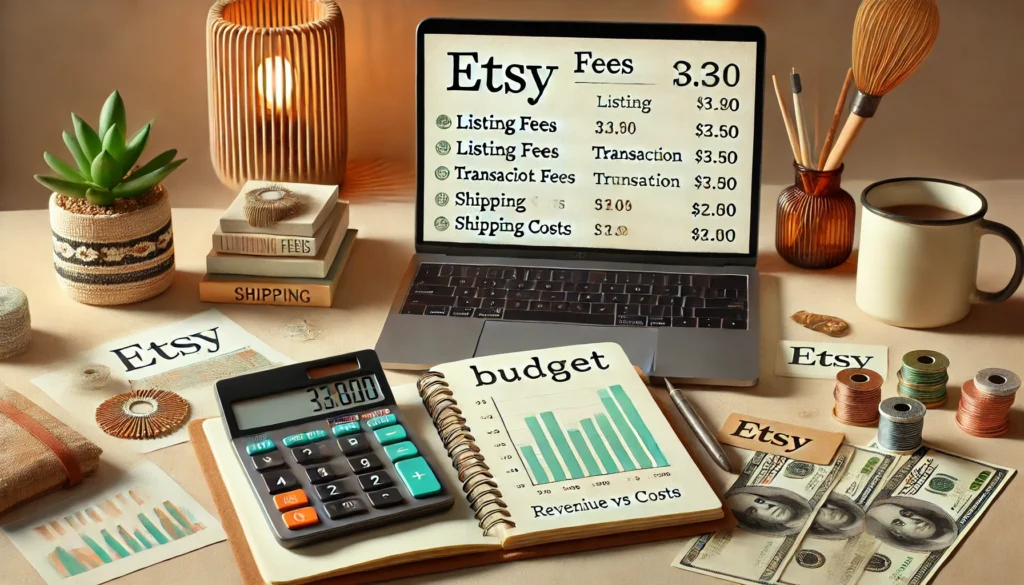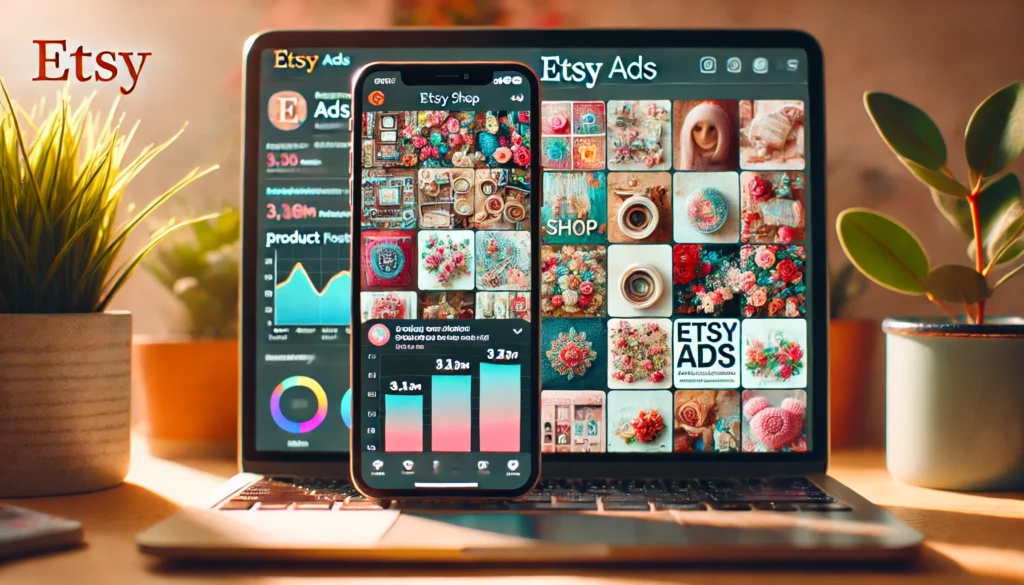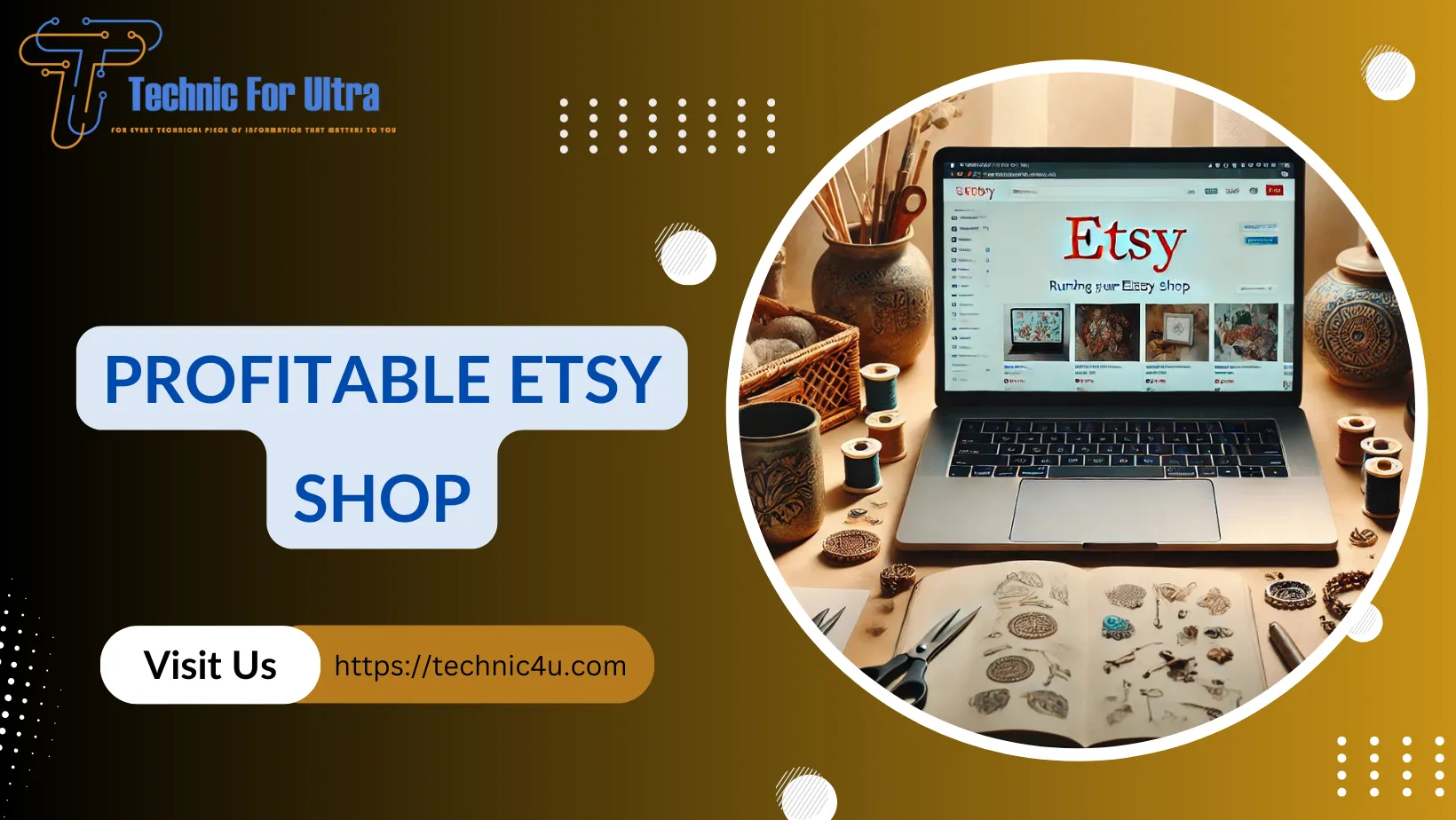Profitable Etsy Shop: Your Gateway to Online Success

Etsy has rapidly become the go-to marketplace for creative entrepreneurs and artisans looking to sell their unique products to a global audience. With its niche focus on handmade goods, vintage treasures, and craft supplies, Etsy offers sellers a platform where creativity and commerce beautifully intersect.
The opportunities for building a profitable Etsy shop are expanding every day. With over 90 million active buyers on the platform, it’s not just a space for hobbyists anymore—it’s a thriving marketplace where small businesses can transform their passions into sustainable incomes. The key lies in understanding how to stand out in a competitive environment while delivering value to your customers.
In this guide, we’ll dive deep into strategies for building a profitable Etsy shop, from crafting the perfect product listings to mastering Etsy SEO. Whether you’re just starting or looking to optimize an existing store, we’ll share expert tips and actionable insights to help you grow your shop and maximize your earnings. Let’s get started on the path to Etsy success!
What is Etsy and Why Should You Sell There?

Etsy is a globally recognized online marketplace that connects creative entrepreneurs with customers who appreciate unique, handmade, and vintage items. Since its launch in 2005, Etsy has become a hub for artisans, crafters, and small business owners to showcase their creativity while reaching a broad audience. The platform focuses on authenticity, offering a space where individuality and craftsmanship thrive.
Types of Products Sold on Etsy
Etsy’s marketplace is known for its diverse range of products, which includes:
- Handmade items: Jewelry, clothing, accessories, home decor, and more, all crafted by sellers.
- Vintage goods: Items that are at least 20 years old, including furniture, collectibles, and art.
- Craft supplies: Tools, raw materials, and kits for DIY enthusiasts.
- Digital products: Downloadable art prints, planners, fonts, and other customizable files.
This variety makes Etsy an appealing platform for both sellers and buyers looking for unique, niche products.
Key Advantages of Selling on Etsy
There are several compelling reasons to start a profitable Etsy shop, including:
- Global Reach: Etsy boasts over 90 million active buyers, offering sellers access to an expansive customer base worldwide.
- User-Friendly Setup: Etsy provides an intuitive platform for creating your store, making it easy even for beginners to get started.
- Specialized Audience: Etsy attracts customers who value handmade and unique items, giving you a dedicated audience for niche products.
- Built-in Marketing Tools: From promoted listings to social media integrations, Etsy offers tools to help sellers increase visibility.
- Scalability: Whether you’re selling as a hobby or building a full-time business, Etsy allows you to scale at your own pace.
By tapping into Etsy’s unique marketplace, sellers can turn their creativity into a reliable source of income. A well-curated store with thoughtful branding and marketing can help you establish a thriving and profitable Etsy shop.
Read also: – 70 Small Business Ideas to Start at Home in 2024
Setting Up Your Etsy Shop

Setting up a profitable Etsy shop begins with creating a solid foundation. By following these steps, you’ll be on your way to crafting a shop that stands out and attracts the right audience.
2.1 Creating an Account
The first step to starting your journey is creating an Etsy account. Here’s a step-by-step guide:
- Visit Etsy’s Website: Go to Etsy.com and click on “Sign in” or “Register.”
- Sign Up: Enter your email address, choose a username, and create a secure password. Alternatively, you can sign up using Google, Facebook, or Apple ID for convenience.
- Open Your Shop: After registering, click on “Sell on Etsy” in the menu. Follow the prompts to set up your store, including selecting your shop’s language, currency, and location.
- Agree to Terms: Read and accept Etsy’s seller policies to complete the account setup.
Once your account is ready, you can move on to personalizing your shop and preparing it for your first customers.
2.2 Designing Your Shop
Your shop’s design is its digital storefront, so it’s essential to make a great first impression. Here’s how to create a compelling design:
Choosing a Shop Name and Logo
- Pick a Memorable Name: Choose a name that reflects your brand and resonates with your target audience. Ensure it’s unique and easy to spell.
- Design a Logo: Use free tools like Canva or hire a designer to create a professional logo that represents your shop’s identity.
Writing a Compelling Shop Bio
- Share Your Story: Let your audience know the inspiration behind your shop. Personal stories create a connection with buyers.
- Highlight Your Unique Selling Point: Explain what makes your shop special, whether it’s your craftsmanship, sustainable materials, or exclusive designs.
- Use Keywords: Incorporate keywords like profitable Etsy shop to enhance your shop’s visibility in search results.
Once your shop is visually appealing and has a strong brand narrative, it’s time to showcase your products.
2.3 Adding Your First Products
Uploading your first product listings is a critical step in launching your shop. Follow these tips for effective product listings:
Uploading Product Listings
- Add High-Quality Photos: Use clear, well-lit images that show your product from multiple angles. Etsy allows up to 10 photos per listing, so take advantage of this to highlight details.
- Write Descriptive Titles: Use titles that include relevant keywords to help buyers find your products easily.
- Create Engaging Descriptions: Detail the product’s features, dimensions, materials, and uses. Write in a friendly, conversational tone that answers common customer questions.
- Set Competitive Pricing: Research similar items to determine a fair price that covers your costs and generates profit.
- Use Tags: Add up to 13 tags with relevant keywords to increase your product’s discoverability.
Finalizing Your Listings
- Choose Shipping Options: Set your shipping policies, including estimated delivery times and costs. Consider offering free shipping to attract more buyers.
- Publish Your Listings: Once everything is complete, click “Publish” to make your products live on Etsy.
By following these steps, you’ll have a fully functional and visually appealing shop ready to start attracting customers. Remember, the key to building a profitable Etsy shop is maintaining quality and consistency across all aspects of your store.
Optimizing Your Listings for Success

Creating a profitable Etsy shop doesn’t stop at listing your products—it’s about ensuring your listings reach the right audience. Optimizing your listings with effective strategies can significantly enhance your visibility and sales. Here’s how to make your products stand out.
The Importance of SEO on Etsy
Etsy’s search engine is a powerful tool that helps customers find what they’re looking for. Search Engine Optimization (SEO) ensures your products appear in relevant searches. By choosing the right keywords and structuring your listings strategically, you can improve your shop’s visibility and attract potential buyers.
Effective SEO on Etsy includes:
- Using Keywords: Keywords help Etsy understand your product’s relevance to a search query.
- Updating Listings Regularly: Keeping listings fresh signals activity to Etsy’s algorithm, boosting visibility.
- Encouraging Positive Reviews: Reviews contribute to your shop’s ranking and credibility.
Choosing the Right Keywords
Keywords are the backbone of Etsy SEO. Here’s how to choose the best ones:
- Research Your Market: Use Etsy’s search bar to explore popular terms related to your product.
- Use Long-Tail Keywords: Phrases like “handmade ceramic mug” are more specific and likely to match buyer intent.
- Incorporate Keywords Naturally: Add keywords to your product titles, descriptions, and tags without overloading them.
- Leverage Tools: Use tools like Marmalead or eRank to identify high-traffic, low-competition keywords.
Writing Persuasive Product Descriptions
Your product description is your chance to sell your product. A compelling description should:
- Highlight Features and Benefits: Explain what the product does and how it adds value to the buyer’s life.
- Answer Common Questions: Include details about materials, size, and care instructions.
- Use an Engaging Tone: Write as if you’re speaking to a friend—friendly, approachable, and persuasive.
- Incorporate Keywords: Sprinkle relevant keywords throughout the description to improve search visibility.
For example, instead of writing “handmade necklace,” use: “This elegant, handmade necklace features sterling silver and a minimalist design, perfect for adding a touch of sophistication to any outfit.”
Using Professional Product Photos
Photos are the first thing customers notice. Investing in high-quality images is crucial to building a profitable Etsy shop. Follow these tips for professional photos:
- Use Natural Lighting: Natural light creates a clean and appealing look without harsh shadows.
- Show Different Angles: Include close-ups and full shots to highlight details.
- Keep It Consistent: Use a similar style and background for all your listings to create a cohesive brand image.
- Include Lifestyle Shots: Show your product in use to help buyers visualize it in their lives.
Remember, a picture speaks louder than words. Clear, attractive photos can significantly increase your conversion rates.
By focusing on SEO, compelling descriptions, and stunning visuals, you’ll create listings that not only attract customers but also convert them into buyers. Optimizing your listings is a key step in running a successful and profitable Etsy shop.
Read also: – How to Build a Profitable YouTube Channel in 2024
Pricing and Managing Etsy Fees

Understanding Etsy’s fee structure is essential for maintaining a profitable Etsy shop. While the platform provides incredible opportunities for sellers, it’s crucial to factor in its fees when setting your product prices to ensure profitability. Here’s a breakdown of the fees and tips to help you manage them effectively.
Breakdown of Etsy’s Fees
Etsy charges several types of fees that sellers should account for:
- Listing Fees: Etsy charges a $0.20 fee for every product you list. Listings remain active for four months or until the product sells, after which the fee applies again for renewal.
- Transaction Fees: Etsy takes a 6.5% fee on the total sale price, including the item’s cost, shipping, and gift wrapping (if applicable).
- Payment Processing Fees: Payment fees vary by country but typically include a fixed fee (e.g., $0.25) and a percentage of the transaction total (e.g., 3% in the U.S.).
These fees may seem small individually but can add up, especially with high-volume sales. It’s vital to include them in your pricing strategy to maintain profitability.
Strategies for Setting Competitive Prices
Pricing your products effectively is a balancing act between covering costs, remaining competitive, and earning a profit. Here are some strategies to help:
- Calculate Your Costs: Start by adding the cost of materials, labor, and packaging to Etsy’s fees. This gives you the baseline cost for each product.
- Research Competitors: Browse similar products on Etsy to understand the price range. Position your price within this range while emphasizing your product’s unique value.
- Factor in Your Profit Margin: Decide how much profit you want to earn per sale. A common benchmark is a 20-30% profit margin above your total costs.
- Offer Bundles or Discounts: Encourage larger purchases by offering discounts on multiple items, which helps offset fees and increases your average order value.
- Include Shipping Costs: Clearly communicate shipping fees or offer free shipping by building the cost into your product price.
For example, if your product costs $10 to make, Etsy fees total $2.50, and you want a 30% profit margin, your product price should be approximately $16.50.
By understanding Etsy’s fees and implementing a thoughtful pricing strategy, you can ensure your shop remains competitive while maintaining profitability. Managing these aspects is key to running a successful and profitable Etsy shop.
Marketing Your Etsy Shop

To build a profitable Etsy shop, effective marketing is essential. By leveraging online tools and platforms, you can increase visibility, attract more customers, and create a memorable brand. Let’s explore how social media, Etsy Ads, and brand identity can transform your shop into a thriving business.
5.1 Leveraging Social Media
Social media platforms are powerful tools for promoting your Etsy shop. Here’s how to use popular platforms effectively:
- Showcase Products: Post high-quality images of your products in use, styled in creative ways to attract attention.
- Engage Your Audience: Use Stories, Reels, and polls to interact with followers and build a community around your brand.
- Use Hashtags: Include relevant hashtags like #EtsyShop, #Handmade, and product-specific tags to increase discoverability.
- Create Product Pins: Share images with direct links to your Etsy listings to drive traffic.
- Focus on Keywords: Use SEO-friendly titles and descriptions to make your pins searchable.
- Join Group Boards: Collaborate with others in your niche to amplify your reach.
- Build a Business Page: Use your page to share product updates, promotions, and customer reviews.
- Join Groups: Participate in Etsy-related or niche-specific groups to connect with potential buyers.
- Run Promotions: Use Facebook Ads to target specific demographics and drive traffic to your shop.
By combining these platforms, you can effectively market your shop to a broader audience.
5.2 Using Etsy Ads
Etsy Ads are a valuable tool for increasing your shop’s visibility. Here’s how to set them up and optimize them:
- Set a Budget: Determine a daily ad spend that fits your marketing budget. Etsy will automatically allocate your funds to high-performing listings.
- Choose Key Listings: Focus on advertising products with strong photos, competitive prices, and positive reviews.
- Track Performance: Use Etsy’s analytics to monitor impressions, clicks, and sales. Adjust your budget and ad content based on what’s working.
- Optimize for Keywords: Ensure your advertised listings use relevant keywords in titles and tags to attract the right customers.
Etsy Ads are an excellent way to reach buyers already searching for products like yours, making it a cost-effective marketing strategy.
5.3 Building a Brand Identity
Your brand identity sets you apart from competitors and helps customers connect with your shop on a personal level. Here’s how to build a strong, consistent brand:
- Define Your Story: Share the inspiration behind your shop and the values that drive your work. Customers love supporting businesses with authentic stories.
- Be Consistent: Use cohesive colors, fonts, and imagery across your shop, social media, and packaging to create a recognizable aesthetic.
- Engage with Customers: Respond to messages promptly, include thank-you notes in orders, and ask for feedback to build loyalty.
- Highlight Your USP: Emphasize what makes your shop unique, whether it’s sustainable materials, customizable products, or handcrafted quality.
By developing a compelling brand identity, you’ll create a loyal customer base that values your products and keeps coming back.
Marketing your shop is a continuous process, but with the right strategies, you can significantly boost your visibility and sales. Leveraging social media, using Etsy Ads, and building a strong brand are all crucial steps to running a successful and profitable Etsy shop.
Read also: – Top 30 Proven Ways to Make Money Online in 2024
Alternative Income Streams on Etsy

Expanding your offerings can help diversify your revenue and create a more profitable Etsy shop. Beyond handmade goods and vintage items, Etsy sellers are increasingly tapping into alternative income streams like digital products and print-on-demand services. These options offer scalability and passive income opportunities, making them an excellent addition to your shop.
Selling Digital Products
Digital products are one of the most lucrative and low-maintenance income streams on Etsy. Once created, they can be sold repeatedly with little additional effort. Popular digital products include:
- Templates: Designs for business cards, resumes, social media posts, and planners that customers can customize.
- Printables: Art prints, calendars, meal planners, and habit trackers that buyers can download and print at home.
- Educational Materials: Worksheets, lesson plans, and ebooks for niche audiences like teachers or entrepreneurs.
To get started with digital products:
- Use Design Tools: Platforms like Canva and Adobe Illustrator make it easy to create high-quality, customizable templates.
- Optimize Listings: Include clear descriptions, keywords, and mockups that showcase how customers can use your products.
- Provide Instructions: Add a PDF or instructions to help customers access and customize their downloads.
Digital products are a great way to generate passive income while expanding your shop’s appeal to a broader audience.
Using Print-on-Demand Services
Print-on-demand (POD) services, like Printful or Printify, allow you to sell custom products without holding inventory. Here’s how it works:
- Create a Design: Upload your artwork or graphics to a POD platform.
- Select Products: Choose from items like t-shirts, mugs, tote bags, or phone cases to feature your designs.
- Integrate with Etsy: Sync the POD service with your Etsy shop, so orders are automatically fulfilled and shipped directly to customers.
The benefits of POD include:
- Low Overhead: You don’t need to invest in inventory or storage.
- Customization: Offer personalized items that cater to niche audiences.
- Scalability: Easily expand your product line without additional costs.
While POD services handle production and shipping, it’s important to price your items to account for the base cost and Etsy’s fees, ensuring your shop remains profitable.
Adding digital products and print-on-demand items can open up new opportunities for revenue while reducing the time and effort required for traditional inventory management. These alternative streams are excellent ways to grow a diversified and profitable Etsy shop.
Best Practices for Long-Term Success

Building a profitable Etsy shop requires more than just great products—it demands consistent effort and strategic practices to maintain and grow your success over time. By focusing on customer service, reviews, performance analytics, and staying informed, you can ensure your shop remains competitive and thriving.
Providing Exceptional Customer Service
Customer service is the backbone of a successful Etsy shop. Happy customers are more likely to return, leave positive reviews, and recommend your shop to others. Here are some tips for delivering exceptional service:
- Be Responsive: Reply to customer inquiries quickly, ideally within 24 hours, to show that you value their time and business.
- Communicate Clearly: Keep buyers informed about order statuses, shipping times, and any potential delays.
- Resolve Issues Promptly: Handle complaints or problems professionally and offer solutions such as refunds or replacements when necessary.
- Add Personal Touches: Include thank-you notes or small freebies to delight your customers and create a memorable experience.
By prioritizing your customers’ needs, you can build a loyal customer base and enhance your shop’s reputation.
Encouraging and Managing Reviews
Reviews play a critical role in building trust and increasing sales. Etsy shoppers often rely on reviews to make purchasing decisions. Here’s how to encourage and manage them effectively:
- Ask for Reviews: Send a polite message after a successful delivery, thanking the buyer and encouraging them to leave feedback.
- Provide Excellent Products and Service: Quality products and exceptional customer service naturally lead to positive reviews.
- Respond to Reviews: Thank customers for positive feedback and address negative reviews constructively, demonstrating your commitment to improvement.
Consistently managing reviews will improve your shop’s visibility and credibility, attracting more buyers to your profitable Etsy shop.
Monitoring and Improving Shop Performance Using Analytics
Etsy offers built-in analytics tools to help you track and optimize your shop’s performance. Regularly monitoring your data allows you to identify trends and areas for improvement. Key metrics to watch include:
- Traffic Sources: Understand where your visitors are coming from, such as Etsy search, social media, or external links.
- Conversion Rates: Analyze how many visitors turn into buyers and identify potential barriers to conversion.
- Top-Performing Listings: Focus on promoting and replicating the success of your best-selling products.
- Customer Behavior: Use data to refine your pricing, keywords, and product offerings to align with buyer preferences.
By leveraging analytics, you can make data-driven decisions that enhance your shop’s profitability and growth.
Staying Updated with Etsy Policies and Trends
Etsy frequently updates its policies and introduces new features to improve the seller and buyer experience. Staying informed ensures you remain compliant and can take advantage of new opportunities. Here’s how to stay up to date:
- Read Etsy Newsletters: Regularly check Etsy’s seller emails for updates on policies, features, and upcoming changes.
- Join Seller Communities: Participate in Etsy forums or social media groups to exchange tips and learn from other sellers’ experiences.
- Follow Trends: Keep an eye on seasonal and industry trends to adjust your product offerings and marketing strategies accordingly.
- Review Policies Regularly: Familiarize yourself with Etsy’s guidelines to avoid accidental violations that could impact your shop.
Staying proactive and informed helps you adapt to changes and maintain a competitive edge in the marketplace.
By focusing on these best practices—delivering exceptional service, managing reviews, using analytics, and staying informed—you can build a sustainable and profitable Etsy shop that continues to grow and succeed in the long term.
Read also: – 30 Passive Income Ideas to Build Wealth Effortlessly
Advanced Tips to Scale Your Etsy Business

Once your shop is established, scaling your business is the next big step toward creating a truly profitable Etsy shop. By leveraging automation, exploring wholesale opportunities, and collaborating with influencers, you can significantly expand your reach and streamline your operations. Here’s how to take your Etsy shop to the next level.
Automating Processes
Automation can save time and reduce errors, allowing you to focus on growing your business. Key areas to automate include:
- Inventory Management: Use tools like Craftybase or Sellbrite to track your inventory, prevent overselling, and sync your stock across multiple platforms if you sell beyond Etsy.
- Shipping: Automate shipping labels and notifications through Etsy’s integrated shipping tools or third-party platforms like ShipStation. This ensures a smoother order fulfillment process.
- Customer Follow-Ups: Automate thank-you messages, order confirmations, and review requests using tools like Etsy’s “Saved Replies” feature or integrations with platforms like Mailchimp.
By automating repetitive tasks, you’ll have more time to focus on strategy and customer engagement.
Exploring Wholesale Opportunities on Etsy
Wholesale can be a game-changer for scaling your Etsy shop. Selling your products in bulk to retailers or other businesses increases sales volume and introduces your brand to a wider audience. Here’s how to get started:
- Join Etsy Wholesale: Apply to Etsy’s wholesale platform to connect with retailers looking for unique products. This allows you to showcase your shop to a professional audience.
- Create Wholesale Pricing: Offer competitive bulk pricing that still maintains a healthy profit margin. Typically, wholesale prices are 50-60% of retail prices.
- Develop a Catalog: Create a professional wholesale catalog with product details, pricing, and order minimums. Tools like Canva can help you design a polished, branded catalog.
- Reach Out Directly: Research local boutiques or niche retailers and pitch your products directly, offering samples to demonstrate quality.
Wholesale partnerships provide a steady revenue stream and help establish your brand as a trusted name in your niche.
Collaborating with Influencers for Promotion
Influencer marketing is a powerful way to amplify your reach and attract new customers to your shop. Here’s how to make the most of this strategy:
- Identify the Right Influencers: Look for influencers who align with your brand and cater to your target audience. Micro-influencers (10,000–50,000 followers) often have higher engagement rates and are more affordable.
- Offer Partnerships: Provide free products or commission-based incentives in exchange for influencer promotions through posts, stories, or unboxings.
- Track Results: Use unique discount codes or affiliate links to measure the impact of influencer collaborations on your sales.
For example, if you sell handmade jewelry, partnering with lifestyle or fashion influencers who regularly post styling tips can drive targeted traffic to your shop.
By automating tasks, exploring wholesale opportunities, and leveraging influencer marketing, you can efficiently scale your Etsy shop and achieve sustainable growth. These advanced strategies not only increase your sales but also position your shop as a professional and profitable Etsy shop in the competitive marketplace.
For more information about Profitable Etsy Shop, you can watch the following videos:
Conclusion
Building a profitable Etsy shop is a journey that combines creativity, strategy, and persistence. From setting up your shop with compelling listings to mastering SEO, leveraging social media, and exploring advanced scaling techniques, every step plays a crucial role in your success.
Providing exceptional customer service, encouraging reviews, and staying informed about Etsy’s policies and trends are essential for long-term growth. Additionally, experimenting with alternative income streams like digital products or print-on-demand services can diversify your earnings and keep your shop thriving.
Now is the perfect time to start or improve your Etsy shop. Whether you’re just beginning or looking to take your business to the next level, the tools and strategies outlined here will set you on the path to success. Remember, every great shop started with a single listing and a lot of determination.
If you’re ready to dive deeper, consider exploring Etsy’s resources, joining seller communities, or experimenting with new products and marketing strategies. The possibilities are endless—so take the first step toward your dream of running a successful and profitable Etsy shop today!
Top Frequently Asked Questions
How to Make a Profitable Etsy Shop
To create a profitable Etsy shop, focus on a few key areas: offer unique and high-quality products, optimize your listings with effective SEO, and use high-quality images to attract buyers. Additionally, actively promote your shop through social media and Etsy Ads, and provide excellent customer service to encourage repeat business and positive reviews.
What Is the Most Profitable Etsy Shop?
The most profitable Etsy shops often specialize in high-demand niches such as personalized items, digital products like planners and templates, handmade jewelry, and home decor. Shops that focus on unique, customizable, or trending products with a clear brand identity tend to perform exceptionally well.
Can an Etsy Shop Be Profitable?
Yes, an Etsy shop can absolutely be profitable! By carefully managing costs, pricing your products to account for Etsy fees, and maintaining a consistent marketing strategy, you can generate a sustainable income. Many sellers also boost their profits by exploring additional income streams like digital products or wholesale opportunities.
How to Make a Successful Etsy Shop?
A successful Etsy shop starts with thorough market research to identify demand. Create standout products, optimize your shop’s branding, and write compelling product descriptions with SEO keywords. Regularly engage with your audience, provide outstanding service, and stay informed about Etsy’s updates and trends to maintain long-term success.
What to Make for an Etsy Shop?
The best products to make for an Etsy shop are those that align with your skills and interests while meeting market demand. Popular categories include handmade jewelry, personalized gifts, home decor, digital products like planners or art prints, and DIY craft supplies. Research trending niches to identify opportunities for unique offerings.

